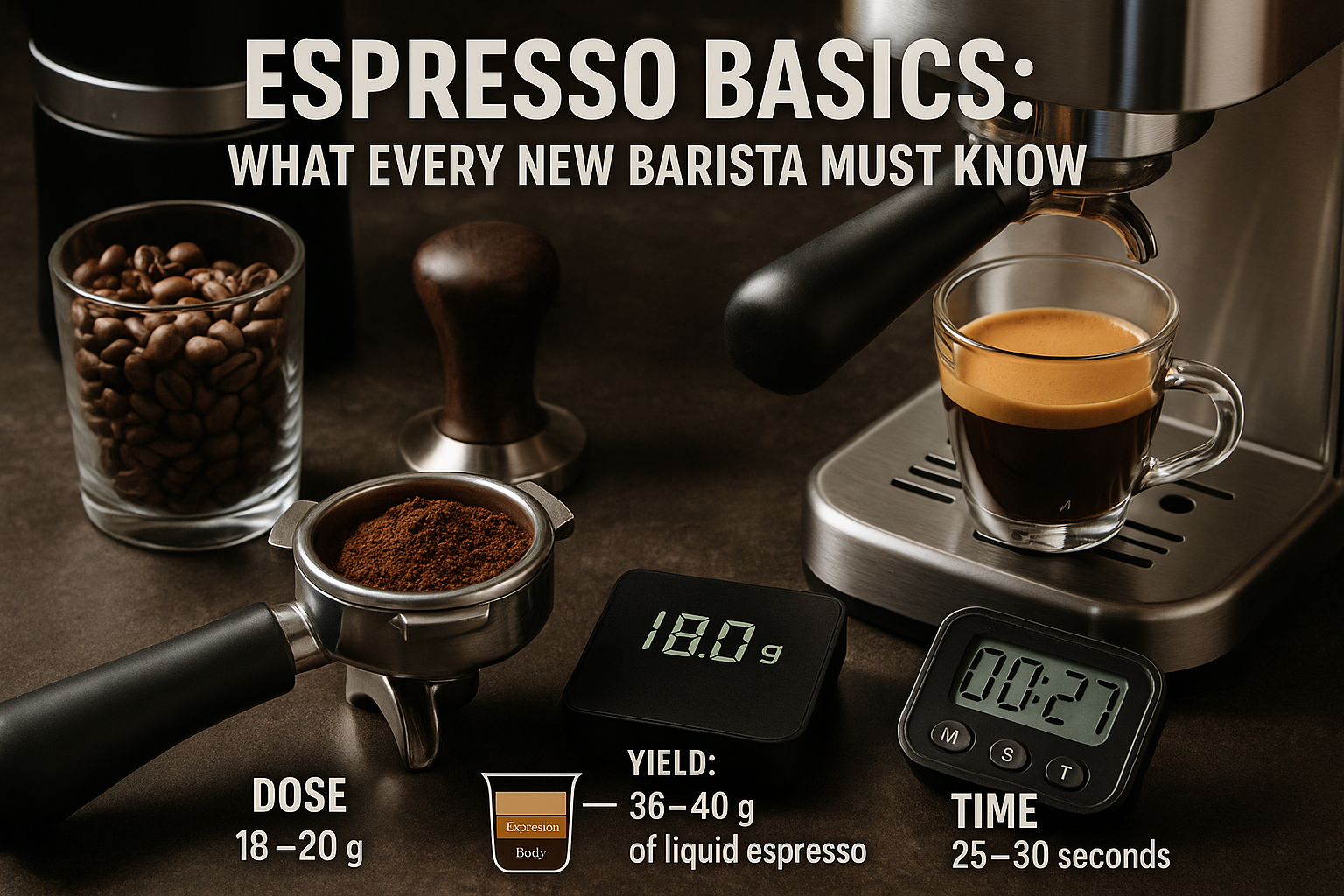Espresso is at the heart of most specialty coffee drinks. Whether it’s a macchiato, latte, cappuccino, or americano — it all starts with a well-extracted shot of espresso. As a new barista, mastering espresso is one of the most valuable skills you can develop.
In this beginner-friendly guide, we’ll cover the fundamentals of espresso — what it is, how it’s made, what affects flavor, and how to troubleshoot common problems.
What Is Espresso?
Espresso is a concentrated coffee brewed by forcing hot water through finely ground coffee at high pressure (typically around 9 bars). It has a bold flavor, thicker body, and a layer of golden crema on top.
Unlike regular drip coffee, espresso is served in small, powerful 1–2 oz shots and forms the foundation for many café drinks.
The Anatomy of a Perfect Espresso Shot
A well-extracted shot has three distinct layers:
- Crema (top): A golden, foamy layer made of CO₂ and coffee oils.
- Body (middle): The main part of the shot — rich and caramel-colored.
- Heart (bottom): The deepest layer — slightly bitter, dark brown.
A balanced shot should taste sweet, slightly acidic, and smooth, without bitterness or sourness.
The Golden Espresso Ratio
A typical espresso recipe follows this ratio:
- Dose: 18–20 grams of ground coffee
- Yield: 36–40 grams of liquid espresso
- Time: 25–30 seconds of extraction
This is known as a 1:2 brew ratio — 1 part dry coffee to 2 parts liquid espresso. It’s a good starting point for beginners.
Essential Equipment for Espresso
To make consistent espresso, you need the right gear:
- Espresso machine with pressure control
- Burr grinder (for consistent grind size)
- Portafilter and basket
- Tamper for pressing coffee evenly
- Scale (measures dose and yield)
- Timer (track shot duration)
Tip: Dialing in espresso without a scale is like baking without measuring — possible, but unpredictable.
Step-by-Step: How to Pull an Espresso Shot
1. Grind Fresh Coffee
Use a burr grinder to grind beans to a fine consistency — like table salt. Always grind fresh for the best flavor.
2. Dose the Coffee
Weigh 18–20 grams of ground coffee and place it in your portafilter. Distribute it evenly using your finger or a distribution tool.
3. Tamp Firmly and Evenly
Use a tamper to press down with 30–40 pounds of pressure. The goal is a flat, even surface for water to pass through uniformly.
4. Insert and Start Extraction
Lock the portafilter into the group head and start the shot. Use a scale and timer to monitor output and duration.
5. Stop at the Right Time
When you’ve reached 36–40 grams of espresso and 25–30 seconds, stop the shot. Taste and adjust from there.
What Affects Espresso Flavor?
Several variables impact how your espresso tastes:
- Grind size: Finer grinds = slower flow, more extraction; coarser grinds = faster flow, less extraction.
- Dose: More coffee = stronger shot; less = weaker.
- Tamp pressure: Inconsistent tamping leads to channeling and uneven flavor.
- Water temperature: Ideal is 90–96°C (195–205°F).
- Freshness of beans: Beans older than 3–4 weeks lose flavor.
Small changes in any of these can dramatically shift the taste.
How to Taste Espresso
Start by evaluating:
- Aroma: Sweet? Nutty? Fruity?
- Body: Light, medium, or heavy mouthfeel?
- Acidity: Bright and lively, or dull?
- Sweetness: Balanced sugar-like taste
- Bitterness: Should be pleasant, not overpowering
Keep a tasting journal and write notes for each shot you pull.
Common Espresso Problems and Fixes
| Problem | Cause | Fix |
|---|---|---|
| Sour or underdeveloped | Under-extracted shot (too fast) | Finer grind or longer brew time |
| Bitter or harsh | Over-extracted shot (too slow) | Coarser grind or lower dose |
| Thin body | Grind too coarse or low dose | Use finer grind or increase dose |
| No crema | Old beans or poor tamping | Use fresher beans, tamp evenly |
Use one variable at a time when dialing in — don’t change everything at once.
How to Dial In Espresso Like a Barista
“Dialing in” means adjusting your recipe for ideal flavor. Here’s a quick checklist:
- Start with a standard ratio (1:2, 18g in, 36g out)
- Taste the shot
- Adjust grind or dose based on flavor
- Retest, and take notes
- Repeat daily as beans age
Dialing in is a daily ritual in most cafés — it ensures every espresso stays consistent and delicious.
Practice Makes Perfect
Espresso is both science and art. The more shots you pull, the better your intuition becomes. You’ll begin to recognize the signs of a perfect shot before it finishes brewing.
Don’t be discouraged by early mistakes — every barista has made them. What matters is that you’re learning how each variable influences the cup.
The Foundation of the Coffee Bar
Espresso is the foundation of the modern café. Learning how to prepare, analyze, and improve your shots will elevate your skill set and give you the confidence to serve great drinks to anyone — even yourself.
Now you’re equipped with the basics. It’s time to turn knowledge into experience — one shot at a time.
